Subscribe now and get the latest podcast releases delivered straight to your inbox.
Competitor analysis tools: 17 essential competitor metrics and how to find them

Jul 23, 2020

Competitor research and monitoring is a must for a growing business, but it is not all just spying on their metrics and repeating their marketing moves.
Competitive research can help you detect and implement trends, reveal gaps in the market and your own digital marketing strategies, and find new ways to attract leads. It overall helps you piece together the bigger picture of your competition's strategy.
There is so much to learn from other businesses’ successes and mistakes.
That's why, below, we’ll tell you about the 17 essential competitor analytics you should be tracking the rest of the year and share the competitor analysis tools you can use to do so.
🔎 Related: How to do a competitive analysis in 5 easy steps
You may be tracking some of these parameters already, but some will certainly be new for you. By adding them to your current competitor monitoring checklist, and you may see your competitive landscape more clearly.
Company background
Believe it or not, there are many factors that can change a company's direction and affect its greater performance and marketing strategy. This includes investments, recruiting, and more.
1. Company overview and CEOs
You should understand basic information about your competitors, including their business location and the size of their staff. You'll need this information to understand your own company's growth against your rival's and how that may impact your performance.
Not sure where to find this information? Start with these tools:
Your competitors' LinkedIn profile will usually show basic information, such as their staff count, but it may not always be up-to-date.
Their CrunchBase will usually go more in-depth, listing their office location, their executive staff and other key employees, and even their foundation date.
2. Revenue and customers
Monitoring the fluctuations in your competitors’ revenue and number of customers will help you scale your own expectations better.
Some helpful tools include:
- Owler
- Crunchbase
Owler is a one-stop-shop where you can view many competitor metrics including a company's annual revenue as well as their expected sales, customer information, CEO insight, and even funding.
Owler provides insight for more than 15 million top global businesses. The estimates are all updated in real-time and they even include future business success projections.
Surprisingly, Google is one of the best free competitor analysis tools.
You can easily search your competitors' names on Google to discover their revenue, their target audience, and how they compare with your brand. You can find this information in press releases and interviews and even on their own websites occasionally.
Crunchbase also offers you to track such data as a company’s revenue if you have a PRO subscription.
3. Geo-targeting
When trying to conquer a competitive international market, it’s important to know what the landscape looks like and how it changes.
Where do your competitors have offices or stores? Where are their customers located? Where is their traffic coming from?
Usually, a competitive landscape analysis generates a matrix with all your rivals being mapped on it.
It's up to you what metrics to put on the grid, whether it be market share, revenue, social media engagement, etc. but overall, it is a great way to visualize your positions against your competitors.
By looking at what countries your competitors are present in or where they're trying to cover, for example, you might discover new markets that you should venture into.
If you’re contemplating opening a new office, check where your competitors are most popular and ask yourself if that’s somewhere you should compete as well.
When it comes to determining where website traffic is coming from, you can use SEMrush Traffic Analytics’ Geo Distribution report.
To use it, simply plug in a website and you can see what countries this website’s traffic is coming from, and how valuable that traffic is based on bounce rate. You can also see historic data for a website to see changes over time for each region.
When it comes to determining office locations, LinkedIn and their company websites are likely your best bets.
4. Reputation
Your competitor's reputation describes how their customers evaluate the product or services. What are people saying about them?
You can track their brand mentions to view both negative responses. You'll view any weaknesses and think of a solution to dominate the competition.
You can use Awario to track your competitor’s online reputation.
Awario is a social media monitoring and listening tool, you can use to not only discover online conversations about your brand but also track what others are saying about your competitors and who works with them.
You likely share the same target audience as your competitors, so you can track their brand mentions to find influencers and other key professionals in your niche.
Awario doesn't just track your competitor's brand name mentions on social media, though. You can also track their mentions on blog posts, discussion forums, news websites, and other web pages.
You can then compare this activity to the number of mentions you receive across all digital channels, so you can know if your marketing tactics are successful against the competition.
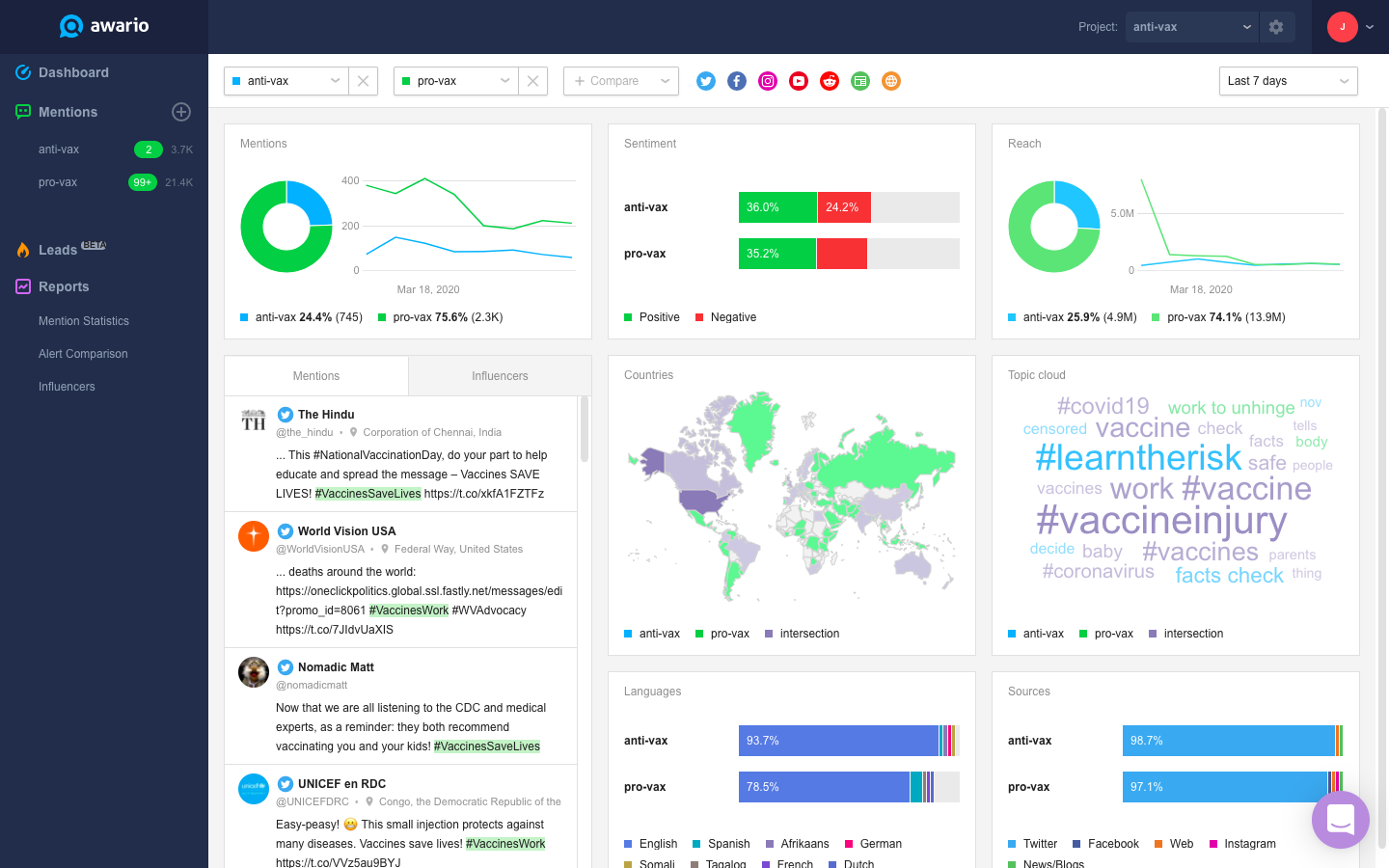
Another way to track your competitor's reputation is to use SEMrush Brand Monitoring. The tool can track mentions based on:
- Company and website name
- Product names
- Product category
- Motto
- And more
SEMrush Brand Monitoring can find these mentions on social media, forums, and web pages. This tool can also help uncover any negative reviews on review platforms and discover any failed products or other liabilities.
To use the SEMrush Brand Monitoring tool, start by adding any specific keywords (such as competitor names and their products).
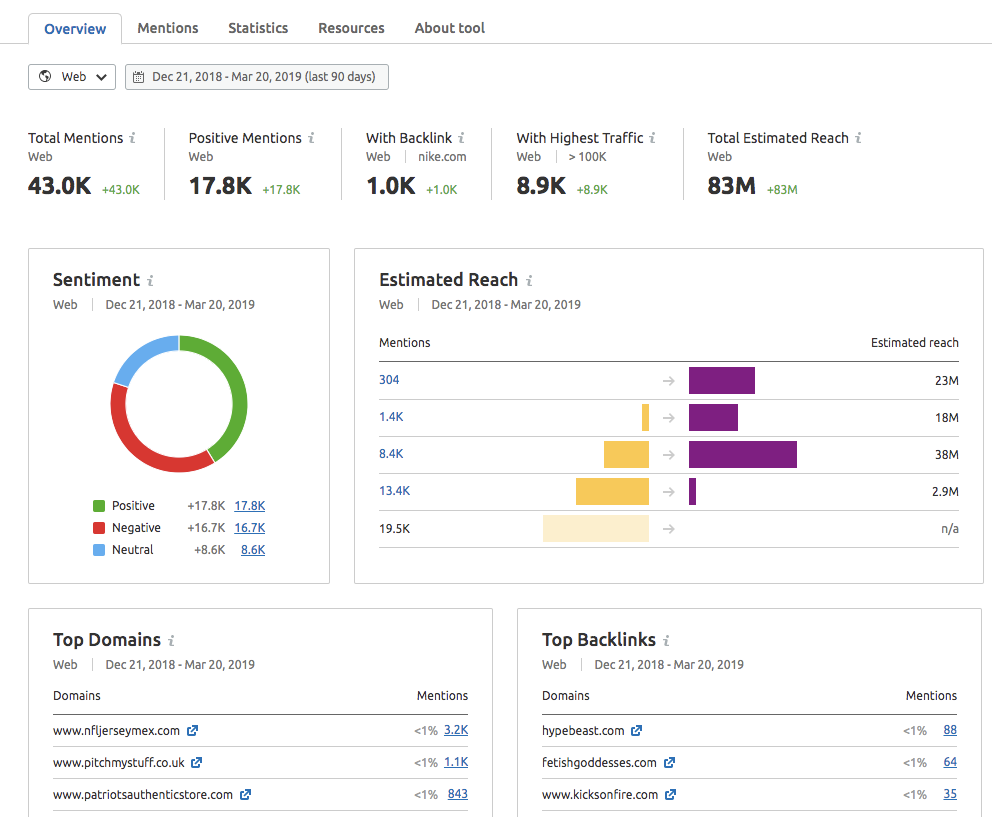
You can also add sources and influencers to better track mentions. From here, you can view mentions and reports based on the keywords you entered.
Market growth
It's essential to know if your competitors are reaching their target audience and their success rates. These metrics also identify any weak areas where you can possibly gain market share.
5. Market traffic trends
Start analyzing traffic dynamics by checking whether your competitor’s traffic is aligned with the market traffic trend. In other words, if the market is trending upwards, are your competitors doing the same.
You can start with checking market trends of your niche and then look at what is your rivals’ approach in terms of these trends. This is especially valuable if your market is seasonal, such as sunglasses and swimsuits.
These actions will help you see if they're on track with expectations, exceeding expectations, or not meeting expectations.
Once you understand how they compare to the overall trends, you can use that to look deeper into what they're doing right or wrong before making adjustments to your own marketing strategies.
To study competitor traffic dynamics, you can use SEMrush Market Explorer to gain insights on individual website traffic versus the market's traffic size.
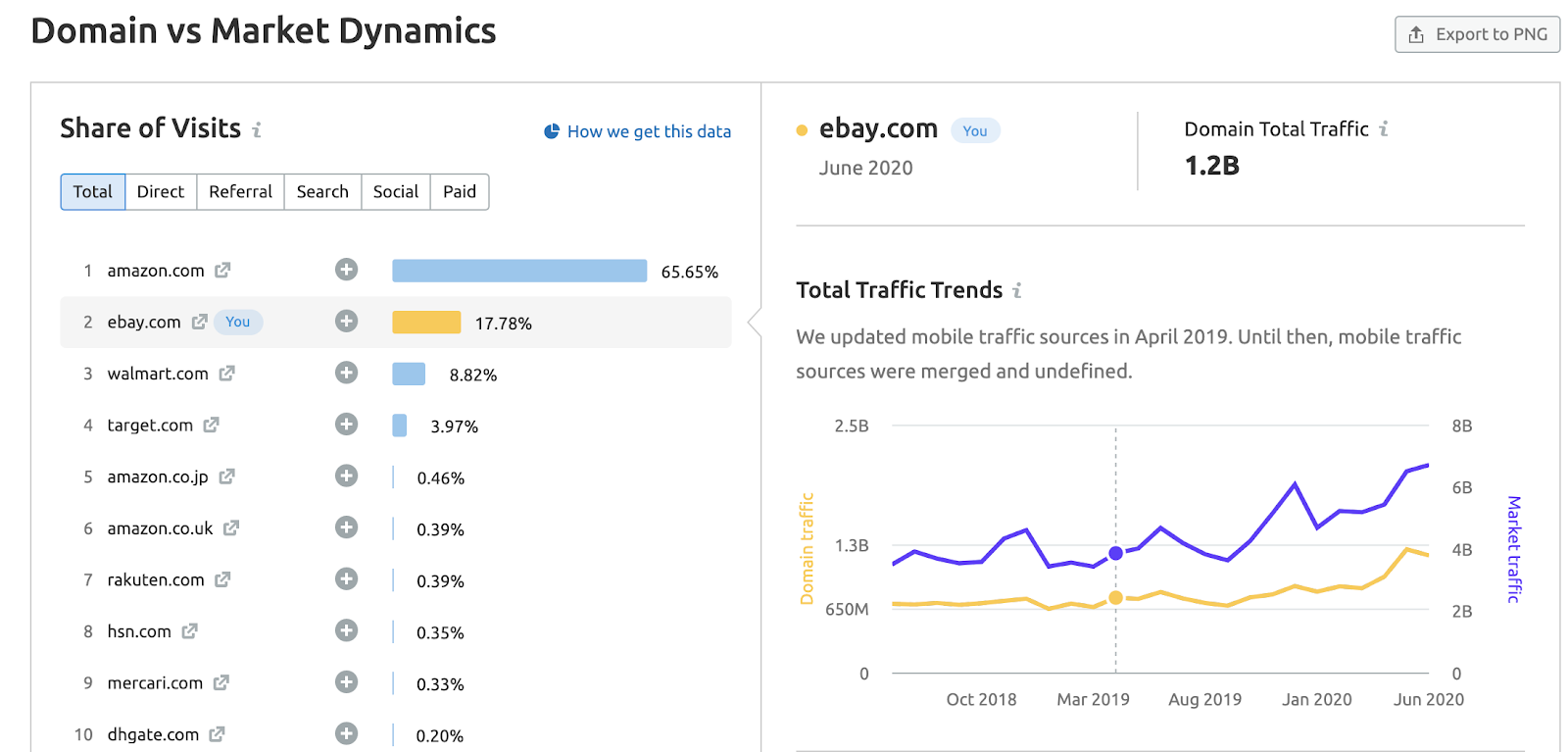
Market Explorer has many features, but you'll benefit from these two viewing options: All Market vs. Narrow Focus.
Narrow Focus lets you identify your website traffic with your closest competitors’ traffic. You can use the All Market option to see how your website compares with the rest of your online competition.
6. Market position
Market positioning is the process of building the brand identity so that customers perceive it in a particular way. In other words, how do your competitors stand in the minds of your customers?
SEMrush Market Explorer can help here once again.
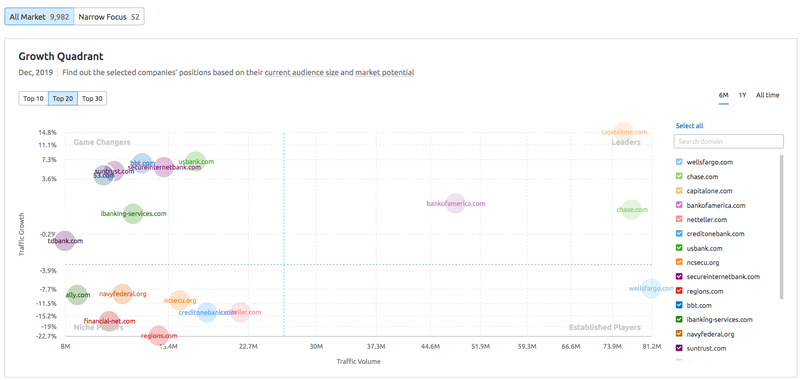
It has a section called Growth Quadrant where you can view the top businesses in your industry based on various criteria.
These businesses are broken down into the following categories:
- Niche players - Those who have small online audiences and are slowly growing
- Game changers - Companies that receive a small amount of traffic but with a growth rate higher than the market average
- Leaders - Businesses with significant website traffic and still growing at a high pace
- Established players - Websites that gain significant traffic volume but don’t grow as fast as some of their competitors
You can view where you are in the quadrants versus where your competitors stand.
This tool shows the business' growth rates and the amount of traffic their website receives and you can adjust these metrics by time frame and country and switch from your closest competition (Narrow Focus) to a broader view (All Market).
Analyzing competitors' digital marketing strategies
Unless you have direct access to your competitor's marketing department, it's impossible to know exactly what they're doing to market their products. However, there are some metrics you should be tracking that will help you figure out what digital marketing strategies your rivals are using.
7. Traffic volume
If a lot of people are visiting their website, that usually means they have more opportunities to reach and convert someone into a customer. That’s why understanding their traffic volume is so important, as well as where it comes from.
You can use SEMrush Traffic Analytics to track your rival’s numbers of visits, unique visitors, and user engagement metrics, monitor the mobile versus desktop share and detect their priority markets by looking at their geo-traffic distribution.
Another tool to track traffic volume is called SimilarWeb. It also gives you information on where your competitors' traffic comes from in terms of sources and geo-distribution.
8. Traffic journey
You may be curious to learn where your competitors’ website audience comes from and where they go next.
This can help you understand how they attract their website visitors and which other actions they are connected to
This is what another SEMrush Traffic Analytics’ report, Traffic Journey, can shed light on.
The feature presents a complete overview of any website’s traffic sources and destination sites, meaning it can reveal any company’s digital strategy, marketing mix, partnerships, and more.
9. Top pages
You may also want to dig deeper to discover the most popular pages on your competitors’ sites.
This can reveal the focus of their marketing campaigns, their most sought-after content, product, and product categories.
Once again, SEMRush can help you identify these pages. The number of users next to them will speak volumes about what’s working for your competitors and possibly what you should focus on.
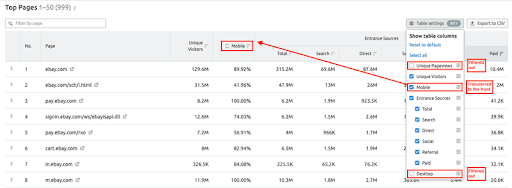
Serpstat is another tool that will help you to check your competitor’s top pages. You’ll be able to see all links of a certain domain for a keyword in the top 10 search results.
10. Search rankings and keywords
Organic traffic from search engines is one of your most powerful assets as it comes to you at no cost.
You'll want to see how your competitors are ranking in search engines and which keywords they're using to see how you can outrank them.
SEMrush has two useful tools for this: Organic Research and Keyword Gap.
Keyword Gap shows the keywords you use and compares your results to your direct competitors. You can list up to five competitors and can choose organic and paid keywords and PLA (Product Listing Ads) keywords.
All you have to do is enter your company name and domain name as well as your competitors' names and websites. Next, choose the type of keyword you want to analyze.
After selecting compare, the tool will show these reports:
- Top Opportunities - Identifying any areas where you're missing keywords or your performance is weak
- Keyword Overlap Chart - Showing overlapping keyword portfolios among you and your competitors
- Keyword Table - Showing the overall performance of your keyword optimization, including areas where you're strong and weak
The Organic Research tool also focuses on keyword research and the keyword gap but also uncovers other ways to dominate your competitors on search engine results.
You can analyze your website and competitor websites to see ranking keywords, the position on Google, website traffic, and performance on both desktop and mobile.
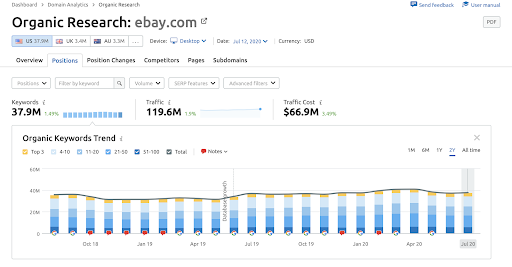
Once again, all you have to do is enter your website or your competitor's website and display a myriad of tools, including:
- Overview Report
- Positions Report
- Position Changes Report
- Competitors Report
- Pages Report
- Subdomains Report
- And more
For best results, study all of these reports and identify your strengths and weaknesses.
11. Backlinks
Achieving high-quality backlinks has a major advantage to your SEO performance as they drive traffic to your website without any additional effort on your part.
Knowing what backlinks your competitors have will help you to gather ideas for your link-building
To compare your backlinks to your competitor's backlinks, you can use the SEMrush Backlink Analytics. All you have to do is enter your website or your competitor's website to track your backlinks.
The Backlink Analytics tool features multiple charts to assist your link building campaign. Y
You can identify all backlinks including linking domains, detect the different types of backlinks, and check to see if your backlinks are from authoritative sources. You can also see if any backlinks were deleted.
12. Engagement on social networks and social media followers’ count
Keeping an eye on your competitor’s social media engagement and follower counts will give you a good gauge of how effectively they are connecting with their audience using the medium.
There are two tools that you can use to track social media followers: SEMrush Social Media Tracker and Sprout Social. This is essential to understanding how many people they have the potential to reach on various social networks.
However, it’s not enough to just track your rivals’ social media followers’ count. To see the whole picture of their social media marketing effectiveness, you really need to know the engagement metric.
This ratio lets you know how much people interact with a certain post and includes such factors as shares, likes, comments, etc. Engagement is the perfect way to analyze content performance, evaluate which keywords work best, etc.
You can use the SEMrush Social Media Toolkit to track social audience, activity, and user engagement.
Go beyond just how many people are following your competitors to look at how many people are sharing, reacting to, and commenting on their posts. This will give you a better idea of how many people they're actually reaching on social media and can help you choose which platforms to focus on.
13. Paid traffic
Similar to organic traffic, you’ll want to see what kind of paid traffic your competitors are enjoying.
You need to find what campaigns and when your competitors are running, which keywords they use, and what landing pages they launch to determine where you can compete.
Use a free tool Google Trends to find profitable PPC keywords and media coverage of a particular topic.
If you want to go deeper with analyzing your rival’s traffic, you can use SEMrush Advertising Research is one of the best tools that will allow you to get valuable insights into these numbers.
With this information, you can learn more about what keywords you can focus on and how you can improve your own landing pages to get more conversions. This can help you save time and money when coming up with your own paid media campaigns.
14. Content performance
Overall content performance can be measured in terms of page views, social shares, and low bounce rates.
Put these metrics together to regularly study how well certain pieces of content do for your competitors so you can find ways to outshine them.
The tools you can use to measure content performance include:
15. Audience age and gender
Metrics like these will help you paint a clear picture of your target audience and come up with better targeting for advertising campaigns.
For example, if your audience is primarily teenage boys, you don't want to be using marketing materials that primarily appeal to middle-aged women.
SEMrush Market Explorer can give you more details about the audience of your competition as well as the audience of the whole market.
16. Audience interests
This is a way to find related topics that your target audience is interested in. This can be valuable data for planning content campaigns to expand your audience and reach new people with your website in the future.
You can start with the SEMrush Market Explorer tool to get some ideas of audience interests.
To take it a step further, start looking at the positive reviews left for your competitors on relevant sites (i.e. G2 Crowd, Yelp, etc.). If they're not anonymous, you can dig deeper to see what people are interested in.
Don't be afraid to browse social media followers as well.
See who else they're following and what types of things they post. This can help you know what they're most likely to share which can help you create more shareable content.
17. Shared audience
Analyzing the overlap between your competitors’ websites (or between your and your competitor’s website) will help you understand how big your new potential audience is and how easy it will be to attract people to your website.
It will also give you further insight into where you stand in terms of market saturation against your competitors.
SEMrush Traffic Analytics’ Audience Insights feature can help you find out the percentage of the audience that visits your and your rivals' web pages and other marketing insights.
Your next steps with these website competitor analysis tools
Now you know 17 different metrics you should be tracking and have at least one competitor analysis tool you can use to learn each of them.
As you go through these steps, take notes.
Focus on things your competitors are doing well so you can follow a similar strategy and on areas where they're weak so you can take advantage of gaps in the market.
By the end of your analysis, you should have a list of things you can start doing differently.
If you want help getting the results you're looking for, book a meeting with us. We would be more than happy to help your business grow and thrive through our unmatched digital marketing services as we've already done for hundreds of other companies.


Order Your Copy of Marcus Sheridan's New Book — Endless Customers!

